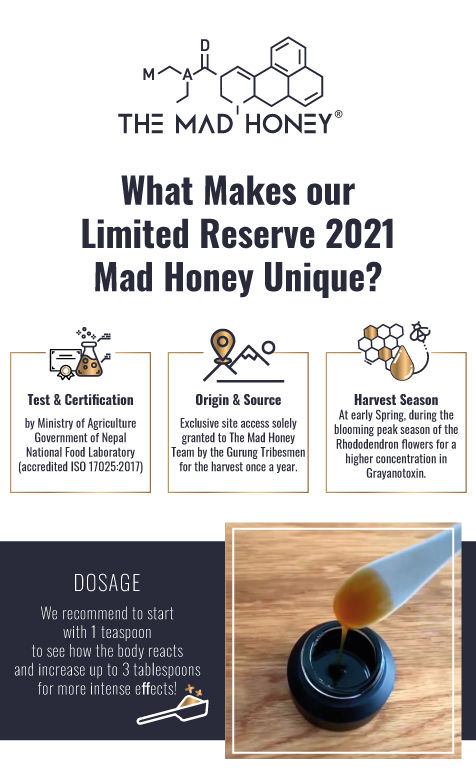Mad Honey Hunting in Nepal
- Mad Honey
- Dec 12, 2020
- 4 min read
Hunting for honey with the Gurung community is a fascinating experience that allows outsiders to discover their hidden treasure aka the mad honey, at an altitude of more than 3000 meters while discovering their unique culture and way of life. By savoring their prized red honey that is traditionally and ethically harvested, you can experience an appreciation of the rich and abundant Nepalese cliffs without even traveling.
The Curio known as Nepalese Honey Hunters
The Gurung honey hunters are not your average country hunters; these men are among the bravest and most underrated heroes you have ever come across.
Twice a year, mad honey is harvested from the deadly Himalayan cliffs. The tradition of honey hunting has been handed down through generations. The knowledge of red honey hunting is sacred to the Gurung community and whilst this art seems to be rendered extinct, the few honey hunters who still subsist are ensuring that their cultural heritage is kept alive by leading the remaining youth who is still fascinated by honey hunting.
Not Your Next-door Bees
The Himalayan honey/cliff bees known as Apis Laboriosa or giant bees are the world's largest honey bees and can measure up to three centimeters in length. These exotic bees differ from other bee species in numerous ways:
Their forewings are over 12 mm in length.
Their nesting behavior is unique; nests are typically composed of a single comb built on overhangs on vertical cliffs.
Nests are commonly present in altitudes above 1200m. Their distribution is restricted to the Himalayas. The bees are most common in mountainous areas of Nepal, Bhutan, India, and some parts of the Yunnan province in China.
Every once in a year, the giant bees gather nectar from white rhododendrons flowers (Lali Gurash) that carry 'mad' characteristics.
Extraordinary Men, Ordinary Lives
The risk taken is no joke albeit it seems like a child's play to the Gurung hunters. The hunters wear little to no protective gear. Originally from Tibet, the hunters moved to the region in the Middle Ages.
They were predominantly subsistence farmers who carried small-scale production of vegetables and livestock and had minimum interaction with the outside world. Their village is at a distance of more than 48 hours of walk from the nearest main road.
''These are people who are very connected to their land, and they’re connected to the spiritual world that comes out of their land.” For a Nepalese Honey Hunter's Last Harvest, Friend and Filmmaker Ben Ayers'99 was there.-Emily McConville
The Process
Honey hunting is not an undistinguished exercise; the Gurung tribesmen perform a sacred ritual including an animal sacrifice known as a Puja to pay their respects to the forest gods for a safe honey hunt. The sacrificed chicken/ sheep/goat is then served as a meal to the head of the honey hunters who is responsible for climbing the rope ladder, extracting the honeycombs, and enduring the honey bee stings. Another meal is typically served after a fruitful harvest. The Annapurna cliffs are vicious and many have lost their lives during their attempts to collect this unique nectar. Their names have been engraved along the cliffs as a tribute to them.
It is common to get rid of wasps by lighting a fire and moving their comb somewhere else. Unsurprisingly, the same is done to drive cliff bees out of their honeycombs; dried leaves are lit, attached to wet ones so that the huntsmen can attach them to their rope and maneuver the smoke while climbing the cliff.
With the aid of a bamboo stick; the hunter works the nest vigorously so as to detach the honeycomb from the cliff. Simultaneously, another stick is used to direct a basket and catch the severed honeycomb. The art of honey hunting not only requires dexterity but also grit which few of us possess. Once the honeycomb is caught in the basket, it is lowered to the ground.
The red honey is consumed in its raw state and is divided among the remaining villagers. Cups of honey tea are served. The honey-hunting site is situated in a remote location that keeps it at bay from foreign exploitation.
The Mad Honey® Harvest
Our harvests take place twice a year for the Himalayan Honey and only once a year for the Limited Reserve to provide the best quality possible. The Mad Honey® believes in an ethical harvest that supports the abundance of this dwindling Nepalese community. Our dedicated on-site team in Nepal is part of the Mad Honey Community; this allows us to have insightful knowledge of the harvests and hunts. Thus, we are able to get our hands on the best quality of mad honey for you.

Superior Honey That Makes you High
We are the first company to trade Mad Honey worldwide and offer an online shop with international delivery. We are experienced and offer a unique experience to each and every customer.
Think we are blowing own trumpets?
Check out our reviews.
We recommend:















Comments